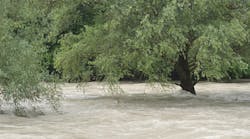Lake Okeechobee Water Quality Improving
In the absence of disturbing hurricanes over the past two years, water quality has improved in Lake Okeechobee, the largest freshwater lake in the southeastern United States, according to the most recent data from the South Florida Water Management District.
Lake Okeechobee, located in the center of the Everglades ecosystem, covers 730 sq miles with more than 100,000 acres of wetland habitats. The past two hurricane seasons have been relatively inactive in the lake region, resulting in low phosphorus inflows and above average environmental conditions.
The lake's phosphorus levels are averaging 77 parts per billion (ppb) across 27 monitoring sites, the lowest of which registered 11 ppb. Shoreline areas are showing the greatest improvements, averaging 33 ppb. Hurricanes Frances and Jeanne hit the Lake Okeechobee area in 2004, sending phosphorus levels up to approximately 300 ppb; Hurricane Wilma sent average levels to more than 300 ppb the following year. Other than Tropical Storm Noel, South Florida has seen little storm activity in 2006 and 2007.
The resulting improved water quality allows more sunlight to reach vegetation dotting the lake's bottom. Area scientists have seen the recovery of submerged aquatic plants across more than 30,000 acres throughout the lake. Also, the ongoing southeastern drought has induced low water levels and thus mud flats around the lake's perimeter; birds not normally seen around Lake Okeechobee have arrived and are feeding on insects and other invertebrates.
In 2006, the Audubon Society of Florida stated in a lake environmental health report: "The most important action that can be taken is to stop the importation of additional phosphorus into the watershed. At the same time that Comprehensive Everglades Restoration Plan and the Lake Okeechobee Protection Plan are being designed to reduce phosphorus inflows to Lake Okeechobee by about 400 tons per year, at a cost nearing a billion dollars or more, an additional 5,000 tons of phosphorus are imported to the watershed each year."
The bulk of the phosphorus that reaches the lake comes from truck and field crops, pastures and dairy operations. Over time, the phosphorus inflow has accumulated to form a thick layer of organic muck that spans 300 sq miles over the lake's bottom; the layer contains about 51,000 tons of phosphorus.
District crews are taking advantage of lower-than-usual water levels, scraping away excess sediments. Earlier this year the drought expoed much of the lake's shoreline, and workers were able to scrape and haul more than 1.9 million cu yd of the phosphorus muck. Also, nearly 3,000 trees were planted to further improve critical aquatic habitats in and around the lake.
"Lake Okeechobee is going to be healthier as a result of this work, said Carol Ann Wehle, district executive director. "Although the drought and current water shortage have brought many difficult challenges, they also provide a real opportunity for environmental restoration in Lake Okeechobee and other sensitive areas."
Source: Environment News Service




